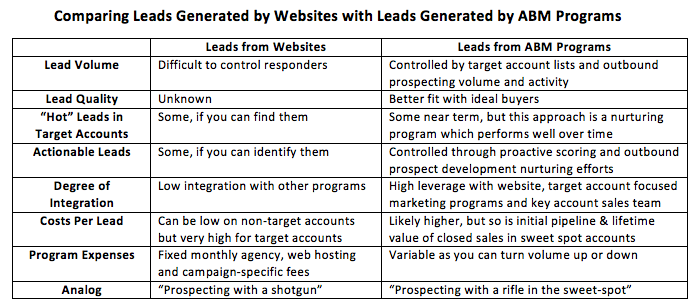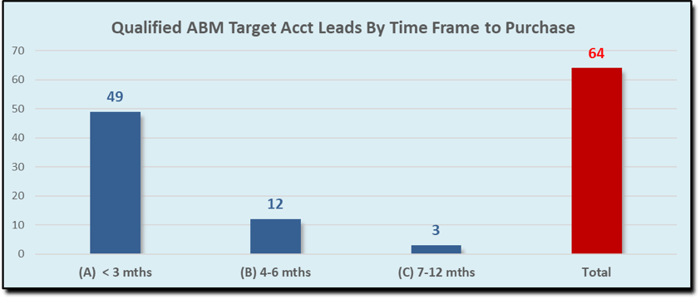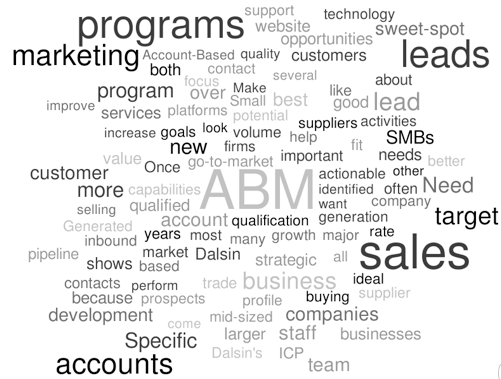CEO Blog - Advice for CEOs on growth and scaling
A Practical Guide to Using Account-Based Marketing: What Small- and Mid-Sized Business CEOs Need to Know

Mark Coronna, Partner & CMO--Chief Outsiders
with Tom Judge, VP Strategy--Direct Marketing Partners
Account-Based Marketing, or ABM, has increasingly captured the attention of marketers in the past several years. If the concept is new to you, don’t worry, you are not too far behind the adoption curve. Small- and mid-sized businesses (SMBs) are the focus of this article for three important reasons:
- ABM is often misunderstood as a shiny new wonder-tech or a label for strategic selling or outbound tele-prospecting programs. We want to clear any misunderstandings up.
- The newest technology and best practices related to high-performing ABM programs are still trickling down to SMBs from much larger businesses which have adopted this approach. But the fundamentals of ABM are at the fingertips of most small/medium firms without expensive technology.
- ABM programs can be scaled to SMBs in a way that makes them both effective and affordable, and can be an integral part of your combined go-to-market and sales program.
Let’s start with a general definition of Account Based Marketing. There are various interpretations out there but here’s one we like.
“A strategic go-to-market approach that orchestrates personalized marketing, sales and success efforts to land and expand named accounts”.
A few years ago, when ABM programs started to get major visibility within the marketing community, to some clients they sounded like another label for strategic selling. There are excellent precedents for these programs, which focus on developing strategic business relationships with the companies in the sweet-spot of your market or named account lists.
But is ABM different? The definitive answer is “yes,” because it integrates the marketing team, sales team, the sales lead generation and lead qualification activities within one framework. ABM puts both sales and marketing on the same team and the same page. There is nothing wrong with strategic selling programs alone, but those programs ignore the opportunities offered by incorporating strategic marketing programs to increase both lead volume and lead quality in select target accounts. ABM delivers an effective and efficient customer acquisition and customer development strategy by integrating all your go-to-market programs and capabilities.
ABM is also very different from the traditional lead generation programs with which you may have had experience. The best ABM programs do use outbound calling and emailing tactics; however, these are not untrained robo-dialing people like you may remember from outbound telemarketing programs in your past. Good ABM programs have highly trained pre-sales prospecting professionals who will often outperform your own sales staff. They are willing to do cold calling deep into the target accounts over a longer period of time than your own staff is likely to complete. ABM service providers can qualify the potential of leads, score them based on your criteria, perform due diligence on them and take them deep in the sales process for a smooth handoff to the sales team. We’ve found that once these programs are up and running, they are a valuable extension of your sales activities. They help increase the productivity of your sales staff because your sales people don’t spend time on the pre-sales vetting stages. To be clear, good ABM partners don’t detract from your brand—they can enhance both your brand and the productivity of your sales staff.
One reason that ABM may be new to you is most of the suppliers of ABM technology and/or services have focused on the high-end of the market. Just as many technologies are first offered to larger companies where the volumes and budgets are larger and the suppliers’ return may be the greatest, ABM programs today are more commonly geared to larger enterprise businesses. That doesn’t mean that you have to accept that, and we will show you why in a moment.
Finally, the perceived issues of effectiveness and affordability for SMBs can be altered as you understand how these programs and their return, has the potential to eclipse many of the sales and marketing programs SMBs regularly use—especially trade shows and web search.
Account-Based Marketing Programs Can Support the Growth Needs of Small- and Mid-sized Businesses
Almost every CEO from a small- and mid-sized business we have encountered expresses a relatively similar set of needs and concerns. The list often is stated like this:
- “We need to build additional sales in our sweet-spot, but how do we do that efficiently?”
- “We do marketing, but I don’t know what programs work”
- “We spend a lot of our budget, over half in fact, on trade shows and I don’t know if we are getting value”
- “Our marketing consists of trade shows, collateral, search, random acts of email and a website. Is that good enough?”
- ‘We have leads, but we don’t have enough qualified leads”
- “I don’t think our sales and marketing staff work closely together”
Account-Based Marketing is not a panacea, so let’s explore how you can address many of those concerns. Every business needs a constant supply of leads. Beyond pure volume, businesses require qualified leads which fit their model of an ideal customer profile (ICP). Businesses with websites are usually getting leads from their web properties, but these leads are largely unqualified because they come from a multitude of companies. History shows us that the majority of these leads are not from their ideal customer or sweet-spot accounts. Thus, the key account sales team is left out in the cold.
For example, think about those who might inquire about a material fabrication manufacturer and their unique production capabilities and applications. You might get inbound leads ranging from the best profile OEM customers which you are looking to develop into customers to individuals at a two -person operation looking to fabricate a wacky invention they designed. Past experience indicates that the majority of these inquiries are not in the sweet spot. Someone in a sales role has to plow through all of those contacts to figure out which leads are the most valuable. That is both an inefficient and time-consuming process. In this model where a website is your major inbound lead source, you have little control over lead volume and lead quality. You may find “hot” leads, but the higher the quantity of leads, the more filtering you will have to perform. You can increase your paid spending to generate more inbound leads, but that doesn’t mean these leads will be any better fit. You know this is inefficient if you look at two ratios: total number of actionable leads in your sweet-spot accounts/total lead volume, and sales conversion ratios (target account leads closed/total leads generated). Single digit numbers usually indicate problems with performance.
ABM, on the other hand, takes a very targeted approach from the get-go. Once you have designed your ideal customer profile, ABM programs can help you find and target these specific companies and the contacts on their buying committee and then deliver your unique value proposition, content and offers for your products or services.
Typical criteria used for ABM targeting are:
- Specific geographies
- Specific companies identified by the sales team or senior management as targets
- Specific companies identified by the ICP and industry SIC or NAICS codes
- Existing customers with further business development potential (i.e. new divisions or locations)
- Specific contact roles or personas on the buying team that you want to get in front of, including VPs/directors/managers over functional areas such as IT, engineering, product development, operations, compliance officers or procurement and any others relevant to your unique company.
Relevant messaging and content are critical:
- Specific messages related to new capabilities, new products or services, promotions which are created to resonate with these accounts and their industry
- Tie-ins to specific sales and marketing events like trade shows, webinars and lunch-and-learns
- Offers must often be of very perceived high value because your competition may be targeting them as well.
Outreach campaigns focused only on selected accounts:
- Create and run specific multi-touch outreach campaigns to only these target accounts
- Monitor your inbound traffic to identify activities from your target accounts and prioritize them
- Once you have engaged your target account contacts, then perform lead development follow-on nurturing, qualification and profiling steps based on prospect quality and interest levels
Track your results by account as well as contact level.

When ABM programs are fully implemented, integration of these programs provides support for lead qualification much deeper in the targeted account sales funnel since leads can be qualified all the way to an “actionable” status. Actionable leads—those high value contacts that have reviewed a white paper, emailed for more info, engaged on calls with your ABM lead development reps, requested pricing information, filled out a request for information form—and are more willing to discuss their requirements and needs. Actionable leads can be handed off to the sales staff, who are appreciative that they are talking with a much more qualified lead than those from the website and trade shows.
Summarizing Business Which ABM Can Address
- Higher return on sales and marketing investments
- Need more qualified leads in select target accounts to support revenue goals
- Need to focus sales staff on the best prospects and opportunities inside your sweet-spot accounts for resource utilization
- Need an expanded pipeline, not just for current opportunities but also for longer-term growth
- Need market research to fine-tune new products or services and understand market drivers
- Need to improve sales staffing to better balance customer acquisition with existing customer development
- Need to optimize limited resources
ABM programs can provide timely pipeline support when you need it for as long as required. ABM programs can have a short-term ramp-up once you have defined your sales targets and goals, invested in building an internal team or located an ABM services supplier which fits your needs. The accomplished ABM suppliers bring best practices to help reduce risk and improve confidence. These programs are what ABM suppliers do for a living, and they will usually do them better than your own sales staff.
ABM programs are also a good fit with SMBs because their start-up fees are limited and can include training and the target accounts and contact list generation. Once you have an ongoing program, you can ramp up ABM tele-prospecting and email activities based on the seasonal nature of your business or other business drivers such a new product launches—giving you financial control. Most CEOs appreciate the nature of variable fees to scale up or down.
Let’s look at a use case to see how ABM works practically.
Case Study: ABM in a Mid-sized Manufacturing Business
Dalsin Industries is a $40-50MM family-owned metal fabricator located in Bloomington, MN. For several years, Dalsin used a website as its primary lead generation engine. This was a competitive advantage for a period of time because many of their competitors came late to using the Internet for marketing.
As the business grew and web performance metrics were better understood, Dalsin execs realized that while the website had good value, it alone was not going to drive the historic rate of growth, which has been 2x industry averages. Dalsin’s conversion rate of web-generated leads to converted sales may have been <3%, meaning that lots of leads had to be generated and qualified to find a small subset of viable prospects. This was found to be quite time-consuming and had unpredictable volumes at times.
The introduction of an ABM program in 2017 had several goals: improve regional penetration of OEMs that meet their ICP, target a specific growth market (energy), and help build a larger and longer-term prospect pipeline. The latter was important as Dalsin’s customers have multi-year product development cycles and Dalsin needed to be identified as a supplier an approved supplier early-on by each OEM.
Dalsin is now on its third iteration of an ABM program. The benefits the company has realized include:
- Expanding the prospect database into firms that fit the ICP allowing more focus on the “best” prospects and customers
- Materially increasing the pipeline (2x over the previous year)
- Exponentially increasing the conversion rate and allowing the business to eliminate poor prospects early
- Reducing costs associated with sales qualification in their sweet-spot accounts
- Extending the sales force
- Supporting controlled entry into new markets and geographies
- Supporting the launch of a new global fabrication supply chain program
Dalsin’s VP of Sales and Marketing, Tom Schmeling, reports:
“When we started, we weren’t sure how this program would benefit us. Now, however, it has become a critical part of our go-to-market programs. Our ABM supplier has learned our business and does a great job of qualifying leads. We look at them as an extension of our Sales group. It’s important to have a healthy website, but due to OEM buying cycles it’s also important to drive leads in the accounts we want to do business in which we will nurture and convert over a longer timeframe. Our program has a nice payback which is important for a smaller company with resource constraints.”
Dalsin’s ABM program is responsible for identifying over 60 major opportunities in target accounts, and the sales volume of the best 12 of these opportunities represents 40% of the current pipeline.

Are There Times When an ABM Program is NOT for You?
Of course there are. Lower value transactional sales or industries that do not have multi-person buying teams are often not a good fit. Likewise, if your business is facing rapidly declining revenue, you are losing existing customers at an unacceptable rate, or you don’t have a willingness to change your go-to-market model, we would suggest that there are other short-term programs to shore up your revenues. Also, if you don’t have specific target account sales goals or outcomes in mind, do not have an ideal buyer or customer profile developed, or have buy-in from both your sales and marketing leaders, you’ll need to do that homework upfront.
What About all the ABM Technology I Keep Hearing About?
We have observed a number of ABM capabilities and platforms that are not quite as relevant to SMBs as they are for larger enterprise firms. The ABM platforms we tested have long term subscription commitments of 1-3 years, fairly large monthly budget requirements for the tech tools, require IT tech stack integration and a trained staffer to run the system, and about three to six months or more to implement. There are also various digital IP advertising platforms and content/website personalization modules or separate tools to consider. However, the IP advertising platforms and expenditures we looked at currently commanded significant purchase commitments, well beyond the means of the small/medium firms for which we performed the research. We anticipate that in years to come, these costs may come down—so stand by for updates.
What are Potential Obstacles to Avoid in Starting an ABM Program?
- Lack of a plan is a major challenge
- Lack of target accounts and contacts level lists or a database of the accounts in your sweet-spot or named accounts. In these cases, you’ll need to use your ICP and your ABM services companies will need to first enhance the company data you may have on hand and or append more companies and contact names
- Make sure your messaging and offers are in sync with these target accounts needs and are seen as valuable
- Make sure you have the ability to make the handoff on ABM-qualified leads to the appropriate sales staff and they must move quickly in the follow up process
- If you can’t address the above first, you may be losing opportunities and wasting money
Free Consultation Offer:
The simplest and fastest way to determine whether an ABM program should receive your consideration is to give one of us a call to discuss your needs and unique scenario. There is no cost to this discovery call.
For ABM strategies contact Chief Outsiders.
For an ABM service provider contact Tom Judge, VP Strategy, Direct Marketing Partners:
Read more here or Email Tom

Topics: Sales and Marketing Integration, Fractional CMO, Go-to-Market Strategy, SMB
Thu, Feb 28, 2019- Press Releases
- Careers
- Case Studies
- Marketing Consultant Company
- Marketing Strategy Consultants
- Marketing Plan Consultants
- B2B Marketing Consultants
- Virtual CMO
- Marketing Consultant Outsourcing
- Fractional CMO
- What is a Fractional CMO
- Healthcare Marketing Consultant
- Marketing Consultant Houston TX Texas
- Marketing Consultant Texas TX
- Marketing Consultant Bay Area
- CEO Blog
- Ebooks Plus
- Executive Marketing Consultants
- Product Marketing Consultants
- B2C Marketing Consultants
- Virtual Marketing Consultants
- Senior Marketing Consultants
- Temporary CMO
- Hire a CMO
- Fractional CMO Salary
- Fractional CMO Responsibilities
- Marketing Consultant Austin TX Texas
- Marketing Consultant Dallas TX Texas
- Marketing Consultant San Antonio
- Helping Private Equity
- Private Equity Blog
- Leadership Team
- Privacy Policy
- Business Marketing Consultants
- Strategic Marketing Consultants
- Marketing Technology Consultants
- Sales and Marketing Consultants
- CMO Job Description
- CMO Salary
- Fractional CMO Agency
- Fractional CMO Services
- CPG Marketing Consultant
- Marketing Consultant San Diego
- Partners
Houston, TX 77056
© 2023 Chief Outsiders


